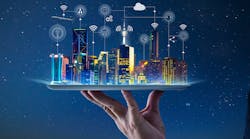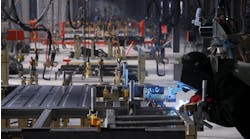Smart-city technologies are typically associated with things like sensing air quality, traffic management, and flood monitoring, but these sensors can be used for more than just natural disasters. They can be utilized for public safety in the form of streetlight outage monitoring and gunshot detection.
Using cities’ intelligence-utility networks, modern sensors are able to, say, detect a gunshot, the location of the incident, the type of gun and bullet used, and share video recording to authorities. Or consider scenarios in which networks autonomously monitor and remedy streetlight outages.
Smart approaches in urban environments are evolving as quickly as they are within our industrial enterprises. Here we chat with Dan Evans, director of smart cities with Itron Inc., to learn more. Take a look…
Smart Industry: What can manufacturers learn from developments on the smart-city front?
Dan: Manufacturers can learn many things from smart cities, in areas such as measuring, monitoring, data integration, flexible connectivity, sustainability and resource management. The foundation of any smart city is a reliable and robust Industrial IoT (IIoT) network where a wide range of community stakeholders can benefit from smart city sensors, data and applications. By adopting similar connectivity solutions, manufacturers can collect real-time data from their equipment, processes, and supply chains, enabling greater efficiency and proactive identification of potential challenges.
Additionally, smart cities prioritize sustainable practices like energy efficiency, waste management, and water conservation, which can be applied to their facilities to reduce any excess energy or water use. Collaboration and ecosystem partnerships are crucial in the smart-city context, as they foster innovation, build resilient ecosystems, and contribute to the advancement of smart-city initiatives.
Lastly, manufacturers can adopt a customer-centric mindset and prioritize user experience. Smart cities prioritize improving the quality of life for residents by providing enhanced services and experiences. By understanding and addressing customer demands, manufacturers can create products and services that meet consumer needs and expectations, driving innovation and delivering value. By embracing these principles, manufacturers can enhance their operations, drive innovation, and contribute to a more sustainable and connected future.
After all, you cannot manage what you do not measure. So, make educated decisions by deploying technology that drives the data to analyze.
Smart Industry: Are there examples of private industrial enterprises aligning with smart cities to, say, share grid access, cross-use data, align sensors, etc.?
Dan: By providing emerging technologies, integrating systems, and enabling data sharing, private industrial enterprises play a crucial role in smart cities. Through these partnerships, cities can use their knowledge and resources to build more efficient and integrated urban landscapes. These partnerships let cities use the knowledge and resources of private industrial enterprises to make cities more efficient and connected.
A few examples of use cases that involve both the city and industry are:
- Air-quality monitoring—for the purpose of creating a safer, more livable city, and to attract more businesses and residents, cities are deploying sensors to provide a more granular view of the air quality in and around the city. With factories and large fleets of vehicles, industrial enterprises are often a major contributor to air pollution. Measuring how the enterprise and city’s collaborative efforts to become carbon-neutral can be enabled with the right sensors and analytics in place.
- Noise monitoring—machinery used by an industry, especially when located outdoors, can be a major contributor to the ambient noise in the surrounding neighborhoods. Working with the city to deploy sensors to collect this data and even set thresholds to alert the city and enterprise when those thresholds have been exceeded could lead to an improved quality of life for the nearby residents and help maintain their property value.
- Fleet electrification—with the move to EV’s coming fast, there are many industries that are looking to electrify their fleet of vehicles (cars, trucks, buses, etc.). While this will greatly reduce the air pollution and noise, it will introduce a significant load on the local electric utility, which is sometimes owned and operated by the city. Coordinating with the city utility on infrastructure build out and management of the vehicle charging schedules can ensure a seamless transition.
These are just a few examples where a strong collaboration between the enterprises and the city can be beneficial to all.
Smart Industry: What is the overlap between public safety and worker safety within plants?
Dan: Public safety and worker safety are intertwined in manufacturing plants, with the shared goal of creating a safe and secure environment for all individuals involved. Public-safety concerns involve the protection and well-being of the broader community, while worker safety focuses on the health and security of employees within a specific workplace. Technologies and solutions that address both public safety and worker-safety concerns are important to achieving these objectives. Something as simple as ensuring appropriate, reliable and safe lighting levels both indoors and outdoors is vital to workers in the plant.
Deploying smart lighting controls can ensure the operations team are made aware of any failures or anomalies to the well-lit workspace. Reliable and stable power-supply systems reduce power outages, benefiting both the public and workers in manufacturing plants.
Efficient energy-management solutions optimize energy usage, reducing power fluctuations and overload situations that could compromise safety. Environmental-monitoring capabilities, such as air-quality sensors and water-quality monitoring systems, help identify and mitigate environmental risks, such as pollution, which can affect overall public health and worker safety. Data-analytics capabilities aid in identifying patterns and anomalies that may indicate safety risks, such as equipment failures, leaks, or abnormal energy consumption. These advancements create a safe and secure environment for the community at large while ensuring the well-being and security of individuals working in industrial facilities, regardless of the vendor providing the solutions.
For example, through a partnership with Itron and Databuoy, the City of Annapolis deployed smart-city technology for public-safety purposes. More specifically, Annapolis integrated smart sensors, mounted to streetlights, and deployed over utility networks, to enable a gunshot detection system. The sensors identify and validate that a gun has been fired, where it was fired from, and what type of bullet was used. The connected communication between the sensors allows for real-time detection and notification of these incidents to the relevant parties (in this case, the Annapolis Police Department). Cities like Annapolis are able to leverage automated intelligence to promote public safety through partnerships with organizations that develop and maintain smart-city technology. The sharing of both sensors and data is an integral aspect of smart cities, especially in the case of public safety.
Smart Industry: What does the near future of smart-city technology look like?
Dan: In the next several years, smart-city technology is expected to advance significantly, characterized by the integration of IIoT devices, advanced data analytics, enhanced energy efficiency, sustainable infrastructure, citizen engagement and inclusivity, and resilience and safety measures. These trends will shape the development of smart cities, fostering improved connectivity, data-driven decision-making, optimized resource usage, citizen participation, and the ability to mitigate risks and enhance the safety of critical infrastructure, along with contributing to crucial decisions needed in response to the impacts of climate change.
Building on natural partnerships between various stakeholders such as cities, utilities, commercial/industrial enterprises, and technology providers, technology will play a vital role in realizing the vision of efficient, sustainable and safe smart cities.


